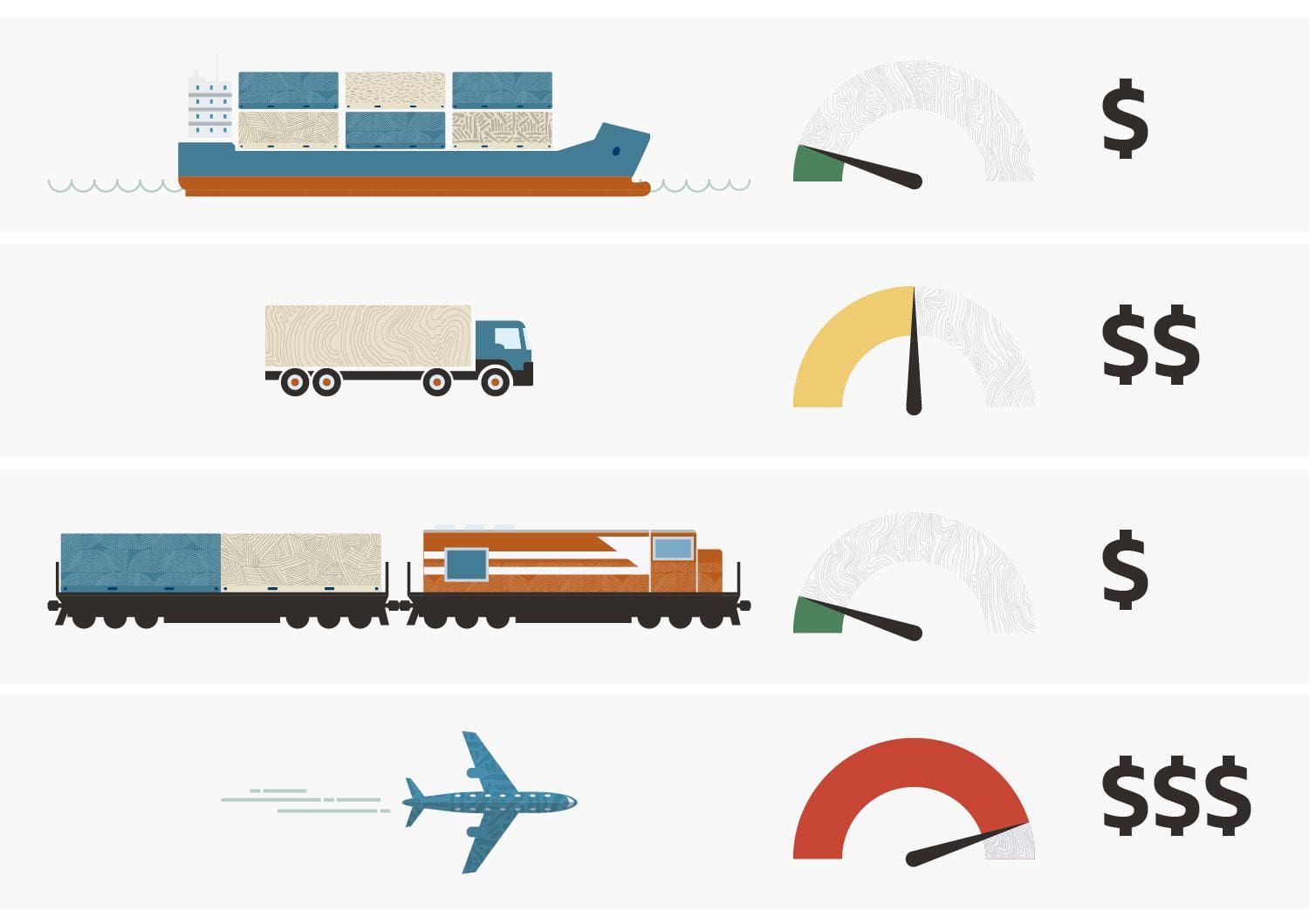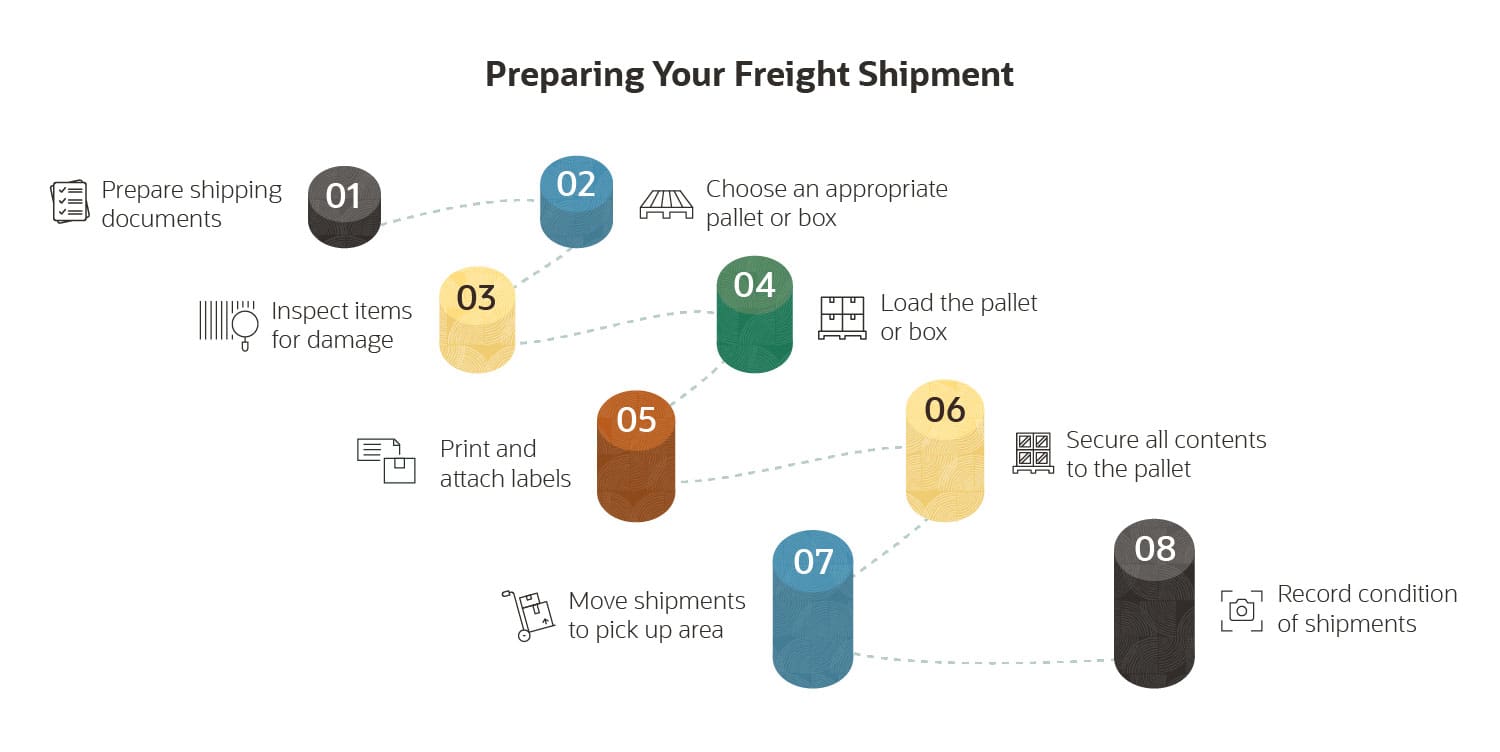If you’ve ever received an especially heavy, large or oddly shaped item at your doorstep, there’s a good chance it traveled there via freight shipping. And most other products you’ve purchased, whether in a store or online, were at some point part of a freight shipment.
Freight shipping is a method businesses use to transport bulk shipments that surpass the weight and size restrictions for parcel packages. This cargo is often packed and shipped on pallets.
Read on to learn more about freight shipping, including what’s shipped via freight, how it works, and why it’s critical to the operation of global supply chains.
What Is Freight?
Freight broadly refers to any cargo that needs to be moved from one location to another and does not qualify for parcel shipping. Most of the things you order online that are delivered to your house or apartment use parcel shipping, which handles smaller packages and boxes.
The parameters used to determine packages that qualify as freight vary depending on the carrier, but it’s often anything that weighs more than 150 pounds, is more than 108 inches long or exceeds 160 inches in length plus girth (two times width plus height). Goods transported on a pallet are usually considered freight.
Almost any item can be freight, including large quantities of smaller goods consolidated on a pallet. Larger products that often require freight delivery are furniture, cars, construction supplies and certain equipment for outdoor activities. The exceptions for common freight carriers are hazardous items like aerosols and fireworks, valuable products like jewels and perishables, including meats and frozen foods. These types of products require more specialized carriers.

What Is Freight Shipping?
Freight shipping refers to the modes of transportation designed to get these larger shipments from one place to another and plays a central role in worldwide logistics networks. This could involve ships, planes, trains, and trucks, and often some combination of those. Imagine a U.S.-based distributor that imports most of the goods it sells from Asia. Those goods must be loaded into a shipping container, then taken across the Pacific to a West Coast port. From there, a truck or train would take those items to their final destination, arriving months after they first left a port in Asia.
Unlike parcel shipments, freight shipments do not travel on the delivery trucks from UPS, FedEx, and Amazon that you’re accustomed to seeing. Since these are large, heavy loads, they require semi-trucks and other modes of transportation with large capacities.
Freight shipments are usually measured based on how much space they would take up in semi-truck trailer. This could be full truckload or less than truckload (LTL), though there are additional options that we’ll get into later.
Key Takeaways
- Freight shipping is one of the most important and widely used methods to transport large quantities of goods around the globe.
- There are not only multiple modes of freight transportation — like truck, sea, rail, and air — but options for shipments of different sizes and weights to meet varying needs and budgets.
- This shipping method is popular because it is reasonably priced, efficient, and can accommodate a wide variety of goods.
- Businesses can lean on technology to see different freight options for each shipment and choose the best one based on cost and the delivery timeline.
Freight Shipping Explained
While it’s rare for consumer orders to arrive via freight, it’s the primary method through which companies receive goods. For some businesses, it’s also the primary way they send items, so it can impact both inbound and outbound logistics. Products companies need large quantities of parts, materials, and finished goods to manufacture or resell, so they order in bulk. Even services organizations will need supplies for their offices and staff, and those often come in large quantities.
Freight shipping is usually more cost-effective and efficient than breaking up this cargo into smaller shipments and sending it via parcel. The processes and equipment needed to move these large and heavy goods is very different than relatively small packages that can quickly be dropped off at your doorstep by a delivery van. Some of the same companies that offer parcel shipping, like FedEx and UPS, also have freight divisions, but they operate as separate units.
Businesses should understand their options and the rules of different carriers rather than defaulting to freight shipping with a known carrier. There could be alternatives that make sense, like splitting up a smaller freight shipment into multiple smaller parcel shipments.
Freight Shipping Modes
Freight shipping is a big bucket, and there are numerous types to meet the varying needs of businesses. The volume, type, and urgency of the goods being shipped all affect which mode makes the most sense. Shipping providers should be able to provide quotes for different options so you can choose the one that makes the most sense for your business.
-
Less than truckload (LTL):
For freight shipments on the smaller side, LTL is usually the best option. As the name indicates, these items do not take up an entire trailer, so you pay less by sharing space with other business’s shipments. While cheaper, it’s slower due to additional stops, unloading, and loading. This also increases the risk of damage. Generally speaking, LTL is a good option for shipments ranging from 150 to 15,000 pounds.
-
Full truckload:
Bigger bulk shipments require a full truckload and usually weigh more than 15,000 pounds. Your goods will travel faster with full truckload because it’s not making extra stops or taking a circuitous route to reach the final destination. This also means your products are less likely to be damaged.
-
Partial truckload:
Though the concept of partial truckload is similar to LTL, it’s slightly different. Partial truckload shipping also splits space with other shippers, but shipment sizes are usually larger than LTL (more than 5,000 pounds). This means only a few companies share the truck, reducing stops and additional handling.
-
Sea transport:
The modes above all refer to transportation by truck, but ships are another critical mode of freight shipping. This is actually the most popular shipping method globally due to its low price and ability to cover long routes. At least 80% of all goods shipped globally travel by sea at some point.
-
Air freight:
Planes are the fastest and often the most direct option to get products from point A to point B. However, this is the most expensive method because of those reasons, so companies often reserve air freight for rush orders or smaller shipments that aren’t as pricey.
-
Rail freight:
Another cost-effective way to move freight cargo, trains are a popular shipping option if you’re not on a tight timeline. Trains may take goods to or from ports to get them closer to the final destination before they’re loaded onto a truck for last-mile delivery. This mode of transportation can efficiently move large and heavy shipments.
-
Intermodal:
Any shipment that uses multiple methods of freight transportation is intermodal, so this could be any combination of ground, air, and sea. Often, the cheapest way to move packages requires multiple modes of transportation, though it will also take longer.
-
Expedited:
This mode is pretty self-explanatory — when you’re on a tight timeline, expedited freight shipping ensures your items will get there quickly. Planes and trucks are both common options for expedited shipments, and you’ll pay a premium for the speed.
Common Freight Shipping Equipment
Not only are there multiple modes of transit for freight shipping, there are also a number of types of equipment used to actually contain the freight when using those various methods of transportation. Some common freight shipping equipment include:
- Shipping containers: If you’ve ever watched a freight train lumber by or spent time near a shipping port, you’ve seen these large metal boxes. Used for transporting goods by sea, rail, or land, shipping containers come in multiple sizes, but the most common are 20-foot and 40-foot in length. Typically made of a rust-resistant steel alloy, these durable containers can withstand harsh elements and last for many years.
- Pallets: A pallet is basically a portable platform used to both transport and store a variety of products. A pallet serves as a sturdy base when stacking multiple items and is built to make it easy to move with a pallet jack or forklift. The size of standard shipping pallet in North America is 48 inches by 40 inches and weighs between 30 and 40 pounds. Wood is the most common material used, although there are also plastic, metal, and paper pallets as well.
- Flatbed trailers: These open-air trailers leave room for oversized or bulky items that may not fit easily in a closed trailer. You’ll see flatbed trailers transporting large machinery, lumber or other agricultural products, for example.
- Reefer trucks: A reefer — slang for refrigerator — truck is a temperature-controlled trailer that freight shippers us to transport perishable goods and other temperature-sensitive products that need to be kept cool during transit. A reefer truck would be the best option when shipping products such as produce, meats, juice, floral, frozen food, computer servers, chocolate, pharmaceutical and lubricants.
Benefits of Freight Shipping
There’s a reason why freight shipping is one of the most common ways shipments are moved around the globe — it simply makes sense for moving many types of large orders. Here are a few of the key benefits of freight shipping that demonstrate why it’s so common:
-
Economical:
Freight shipping is a cost-effective way to transport large quantities of goods from one place to another, especially if you use ships or trains. This is especially true with LTL, which greatly reduces the price of transporting products by truck. Lower costs are especially important in a time of skyrocketing shipping costs.
-
Range and quantity of items:
Freight shipping can accommodate loads that include many pallets and the heaviest and most awkwardly shaped packages. Few other methods can match the wide range of goods that freight can handle.
-
Eco-friendly:
The ability to consolidate shipments for multiple companies on ships, rail cars, and trucks makes the most of each trip and prevents additional emissions-generating journeys. This is an increasingly important issue as consumers pay more attention to the environmental impact of the companies they buy from.
-
Variety of options:
Not only can freight shipping handle all types of goods, but it also gives businesses plenty of options for different speeds, costs and shipment sizes. This broad selection allows shippers to choose the option that best suits their needs for any given transport.
-
Consistency:
Although recent supply chain snafus have affected all shipping methods, freight is generally a reliable way to move products and ensure shipments arrive by the promised date, increasing on-time delivery and other distribution KPIs. Even LTL shipments often follow a regular schedule because carriers will group regular customers from the same area together and follow a consistent timeline.
Factors That Determine Freight Shipping Rates
If a company is unsure whether they should ship goods via freight or parcel, they can use online estimator tools from different carriers to get a sense of the cost. Generally speaking, the amount of total shipping capacity consumed by your shipment is a primary factor in overall price.
Below are a number of the variables that will impact the price of shipments:
-
Distance:
An obvious one, but the total distance your package needs to travel will affect the price. A Trans-Pacific trip will be more expensive than a train moving your goods to another city that’s 300 miles away.
-
Timing:
High-priority rush shipments will always cost more than those that move slower. The more flexible you are with the delivery date, the cheaper it will be.
-
Mode of transport:
As noted earlier, freight covers transportation by truck, rail, sea, and air. The mode of transportation will have a big impact on the price. Ocean freight is usually the cheapest option, followed by rail, truck, and air.
-
Weight:
There’s a big difference between moving a 200-pound item and a 3,000-pound collection of pallets, and prices will reflect that. The greater the weight of a shipment, the harder it is to move and the less capacity there is for other goods, increasing costs.
-
Size:
Will your box take up a small corner of the truck bed or a quarter of all available space? How tall is your pallet of goods? As you would guess, the larger your items, the more you’ll pay.
-
Location:
The pickup point for your shipment affects rates in a few different ways. How close is it to the carrier’s nearest location? Is it close to pickup spots for other businesses that may join your journey? These can all factor into the price.
-
Time of year:
Weather can be a major issue when moving goods, whether it’s unfriendly seas or highway closures due to snowy roads. These issues tend to strike more at certain times of year, which will affect how much you pay.
-
Density/stowability:
How well do your items pack down? Do the dimensions suit a shipping container or truck trailer and leave space for other products? This affects the amount shippers can fit in a total load and therefore is a factor in price.
When to Consider Multi-Weight Instead of Freight
Multi-weight compares the price of breaking up a shipment into multiple packages — perhaps sending all or some by parcel — and consolidating everything into one shipment. It’s a useful tool when you have multiple boxes or pallets all departing from the same location and heading to the same destination. Some tools will automatically choose the cheaper option after you plug in details about your packages.
Multi-weight can reduce landed costs for your shipments by helping you pick the best option. It also eliminates the time it would take to manually calculate the expense of these different options. There are minimum and maximum total weights and dimensions per package and for the total shipment, so not all shipments are eligible for multi-weight.
If freight and multi-weight offer similar prices for your shipment, there are a few other factors to consider. Multi-weight shipments don’t need to be palletized or packed in a special area of our facility. This also means the pallet itself won’t count toward your shipment weight, and the drop-off point doesn’t need the docks or lift-gates required for pallets. Multiple boxes also make for easier delivery in big cities that are hard for large box or semi-trucks to navigate.
How to Ship Freight
If you’ve determined freight is the best way to ship your goods, you’re now trying to figure out how to prepare your items. Let’s walk through the steps you should take to get your goods ready for a freight carrier.
- Prepare any documents required for the shipment, including those that the carrier will need to review.
- Choose a pallet, box or crate that’s the right size for the shipment and has no substantial damage.
- Check the items for any problems and replace them or, if it’s more minor, make note of it. This helps you track any damage caused by the shipper.
- If using a pallet, stack the boxes or items vertically in a consistent pattern, making sure that nothing is hanging over the edges. In other situations, carefully load everything into a box or crate. Use padding or other protective materials as necessary.
- Create labels with the destination address and the contents of the pallet or box and attach them to the shipments. This could include barcodes or other unique identifiers.
- Use straps, bands, and shrink wrap to secure all the contents to the pallet or within a container.
- Move the packaged shipments to the appropriate area of the building where the carrier will pick them up. Check all pallets and packages for complete and accurate labels.
- Take pictures of each pallet or package to show their condition before the carrier takes possession of them. Again, this will come in handy if something goes wrong later.

Future Trends in Freight Shipping
A number of factors, including technology advancements, sustainability pressures, and changing customer expectations, are driving shifts in the freight shipping industry. Some future trends to keep an eye out for include:
- Increased digitalization and automation: Technology capabilities including blockchain, Internet of Things, and freight management systems enabled by artificial intelligence (AI) have the potential to transform freight shipping. These technologies could unlock greater transparency, better security, real-time monitoring, route optimization, and more.
- Vehicle advances: The rise of electric vehicles is already improving last-mile delivery and could hold some promise for other aspects of freight shipping in the future. One report (opens in new tab) shows that 14% of fleets currently operate electric vehicles, and 87% expect to have them within five years. Autonomous vehicles will also have an impact, with testing being done on autonomous ships, for example.
- More sustainable solutions: Alternative fuels, such as liquefied natural gas, hydrogen, and biofuels, to reduce greenhouse gas emissions; more energy-efficient vehicles and vessels; and carbon offset programs are all on the agenda for leading shipping providers.
- New delivery options: Freight shipping has historically taken a one-size-fits-all approach to delivery timelines. In other words, it gets there when it gets there. But customers are demanding definitive and sometimes quicker delivery options and personalized services, putting pressure on shippers to offer more flexible delivery options.
- Disruption mitigation and management: From port closures to blocked transitways to labor strikes, the freight shipping industry has seen more than its fair share of disruptions in recent years. Supply chain resilience will continue to be top of mind looking forward, with companies diversifying their partnerships and employing advanced analytics and AI to predict and handle possible disruptions.
Managing Freight and Commerce With Software
Many companies have recently doubled down on their investment in supply chain technology as they recognize the tremendous value it can add to their organization. Supply chains are a primary source of expenses for products businesses, so any efficiency gains in this area can make a big difference. A big piece of that is supply chain software that manages the entire order-to-cash process.
When it comes to freight shipping, a solution like NetSuite Warehouse Management System (WMS) helps with picking, packing, shipping labels and order staging. NetSuite WMS supports multi-order packing so you can prep multiple orders for shipping at once. You can also use the system to print custom carton and pallet labels as well as bills of lading so everything can be closely monitored. NetSuite also integrates with leading shipping software that will show all available shipping options based on package size and weight. This is where you can compare rates for the various types of parcel and freight shipping and the expected delivery dates for each to always find the best option.
NetSuite WMS and Inventory Management can also help with incoming freight shipments. Users can set up putaway rules in the inventory management system that direct putaway of new inventory and automatically assign expiration dates to items where that’s necessary. The WMS also integrates with barcode scanners for faster putaway and greater accuracy. The inventory management system ensures a company actually has the inventory it’s offering available, and the WMS then guides workers through the pick, pack and ship process. Together, all of this functionality facilitates a positive customer experience that will keep customers coming back.
Shipping is complicated when you’re sending out hundreds or even thousands of orders per day, and you need the right tools to effectively manage this piece of your business.
The majority of products you use every day, whether a bar of soap, laptop, or dining table, were likely part of a freight shipment at some point in their long journey to you. It’s a critical method for transporting goods around the globe, if largely invisible to most of us.
Any business that deals in bulk shipments — sending or receiving — should have at least a basic understanding of freight shipping because it’s a key piece of their supply chain. Not only can it reduce transportation costs, but it’s sometimes the only option for moving heavy or large items. Understanding what goes into the price calculation for freight shipments and having access to the right tools will help companies take full advantage of freight shipping.
Freight Shipping FAQs
What can be shipped via freight?
Almost any item can be shipped via freight, as long as it is not hazardous (like explosive products), perishable (like produce) or especially valuable (like rare gems). Even in those cases, there are specialized carriers who will help you transport the goods. However, shipments must meet minimum weight or size requirements to qualify for freight shipping, which is why pallets with dozens or hundreds of smaller goods are common.
How do I know what type of freight solution my business needs?
The best freight solution to meet your needs will depend on your budget, shipment size, and required delivery date. Less than truckload, or LTL, is a popular option for smaller shipments because it’s much cheaper than paying for an entire truckload but can be slow. Intermodal freight shipping uses multiple modes of transportation, like air and train or sea and truck, and the methods you choose will dramatically impact the price and delivery timeline. For a complete breakdown of different types of freight, see the Freight Shipping Modes section.
What’s the difference between parcel and freight?
Parcel is for smaller and lighter shipments, generally under 150 pounds and less than 108 inches long or 160 inches in length plus girth (two times width plus height). Most of the items that arrive at your doorstep, from shoes to electronics to home improvement tools, arrive via parcel. Freight is primarily used by businesses to cost-effectively move large quantities of goods around the globe, including by sea, truck, rail, and air.
What is freight classification?
Freight classification is a framework from the National Motor Freight Classification (NMFC) that helps determine the price of less than truckload (LTL) shipments. Freight class is based on the density (weight relative to size), liability (based on value), handling requirements, and stowability. There are 18 freight classes with numbers from 50 to 500, and the higher the number, the more expensive the shipment.
Is it cheaper to ship or to freight?
When it comes to transporting goods, companies have a plethora of options to choose from as they consider factors such as the size and volume of the goods being moved, the speed with which the delivery needs to happen and the cost of the shipping option.
When considering cost specifically, the amount of total shipping capacity consumed by your shipment is often the primary factor in overall price. Freight shipping is the term for large, typically heavy shipments of goods transported by water, land or air. Air freight is the fastest and most expensive of the freight options. Ocean freight is the slowest but often most economical, particularly for international shipments. Road (truck) and rail options can offer reasonable alternatives somewhere in the middle, depending on fuel costs and other factors, such as proximity of rail stations to a domestic shipment’s destination. Rail tends to be less expensive than trucking but offers less flexibility.
The other shipping option — typically referred to as parcel shipping — is less often used for long-haul commercial shipping because it is less inefficient and more expensive. While a small retailer or individual would opt for parcel shipping for individual orders, larger companies moving whole pallets or trailers of goods would not. Parcel shipping costs vary based on weight size, transport method and delivery speed.









